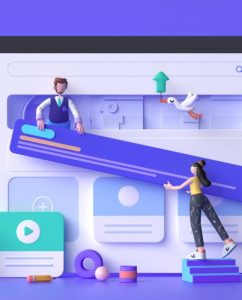Choosing the perfect colour scheme. Finding typography that compliments a logo. Creating an eye-catching brand that stands out from the crowd. These are all things a graphic designer does in a day.
In today’s visually driven, highly competitive world, graphic designers play a crucial role in shaping how we interact with brands. They take an idea, or a feeling, and turn it into a visual that clearly conveys that message.
So, if you’ve got a keen eye for detail, graphic design could be your perfect job. But, how do you begin this journey? Here are five tips on how to fully unleash your creative potential as a graphic designer.
Learn the skills
First things first – you need to understand the field you’re getting into. While you don’t need formal qualifications or training to become a graphic designer, you’ll still need to know the basics.
Make sure you understand things like composition, colour theory and typography before starting to design for clients. Familiarise yourself with design software tools such as Adobe Photoshop, Illustrator, and InDesign, as they are widely used in the industry. Learning these skills will take your work to a professional level, making you much more desirable to new clients.
Look into formal training
While you don’t need qualifications to become a professional graphic designer, formal training can help. The graphic design landscape has changed drastically over the past few years and continues to change daily. Staying up to date with the latest tools, trends, and skills requires frequent learning.
There are countless courses you can do both online and offline. These courses can be taken as a full-time commitment or as a part-time course for more flexibility. While some courses may charge, there are plenty of free online tutorials to choose from. Not only will this increase your knowledge, but any added qualifications will also look good to potential clients.
Create a portfolio
One of the most important things a graphic designer needs is a portfolio. A portfolio can easily show potential clients your work process, skills, style, and versatility.
This might go without saying, but your portfolio should have your best work. Don’t include messy and unprofessional designs from the early days. Plus, the format of your portfolio should also look as professional as the rest of your designs. Make sure to include your creative process as well, clearly showing the different stages of design, so the client understands what they can expect from you. Remember to curate your portfolio carefully, showcasing only the best and most relevant work. Doing so is sure to leave a lasting impression.
Learn to listen to feedback
As a graphic designer, your job isn’t just to make nice images. An essential aspect of your job is communication. Listening and acting on feedback is the key to happy clients.
It’s important to remember that feedback goes both ways. Don’t expect to create the perfect design on your first try, be prepared for some client critiques. However, it’s also important to remember that you’re the professional. If a client is suggesting a design choice that you know won’t work, tell them. Yet, even the best graphic designers can make mistakes, so remember to invest in some specialist designer insurance to keep yourself covered.
Networking
This is another essential area for graphic designers that is often forgotten about. Networking doesn’t just open doors to potential clients or job opportunities, but it’ll also provide valuable mentorship, insight, and inspiration.
There are several ways you can network with fellow graphic designers. You can attend industry events, join online communities, or visit professional organisations. It can seem daunting, but don’t be afraid to introduce yourself to people. Make sure to carry business cards with you, and don’t be scared to follow up with the people you meet.
Unleash your potential
With these five tips in mind, you’re sure to succeed as a graphic designer. With plenty of knowledge, some formal training, an impressive portfolio, good communication skills, and plenty of networking, you’re sure to become an incredible graphic designer! Remember, good graphic design should complement a business – not overshadow it.
All that’s left to do is to put in the hard work and unleash your creative potential. Don’t be afraid of the challenges that lie ahead. Stay passionate, positive and proud. You’ve got this!


